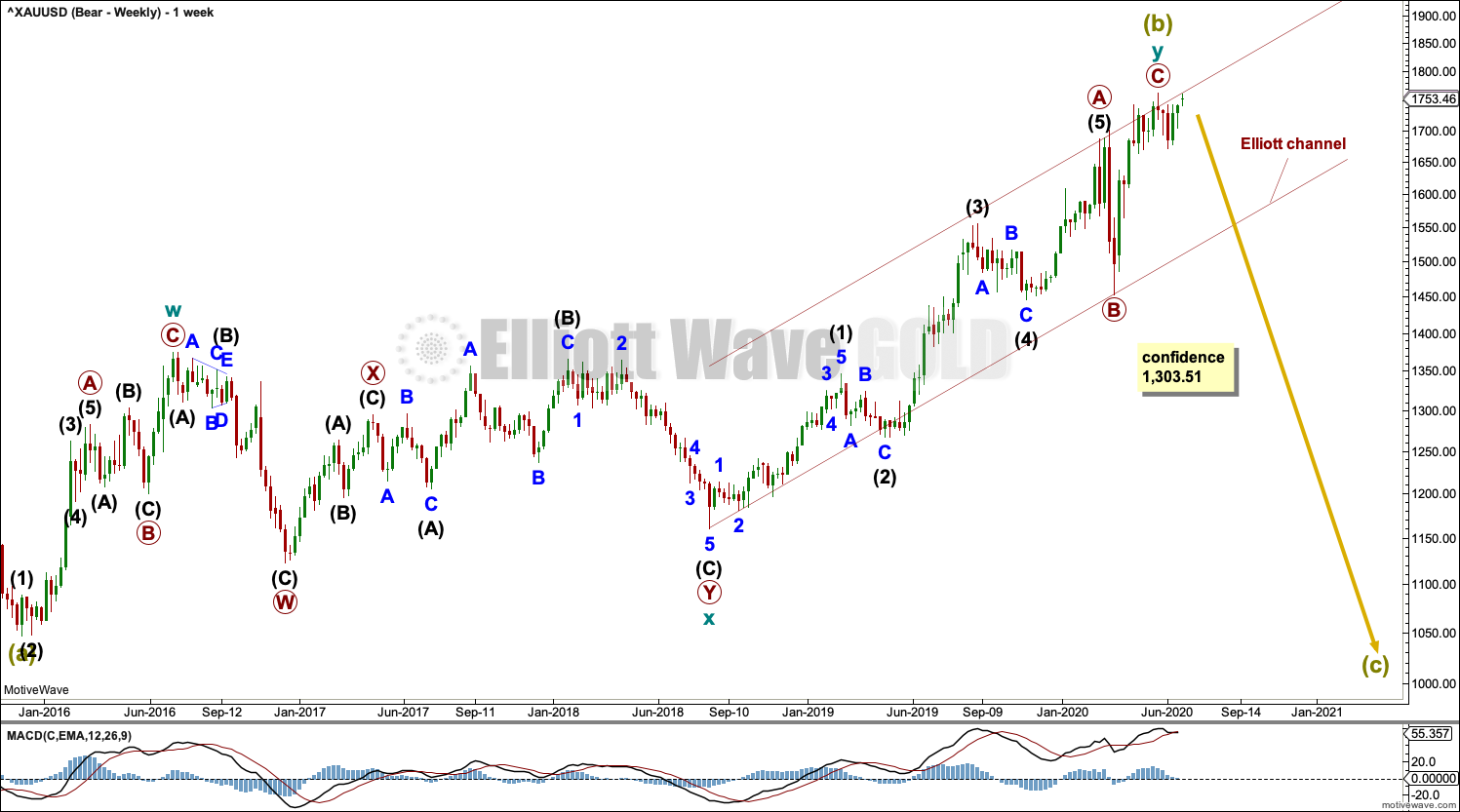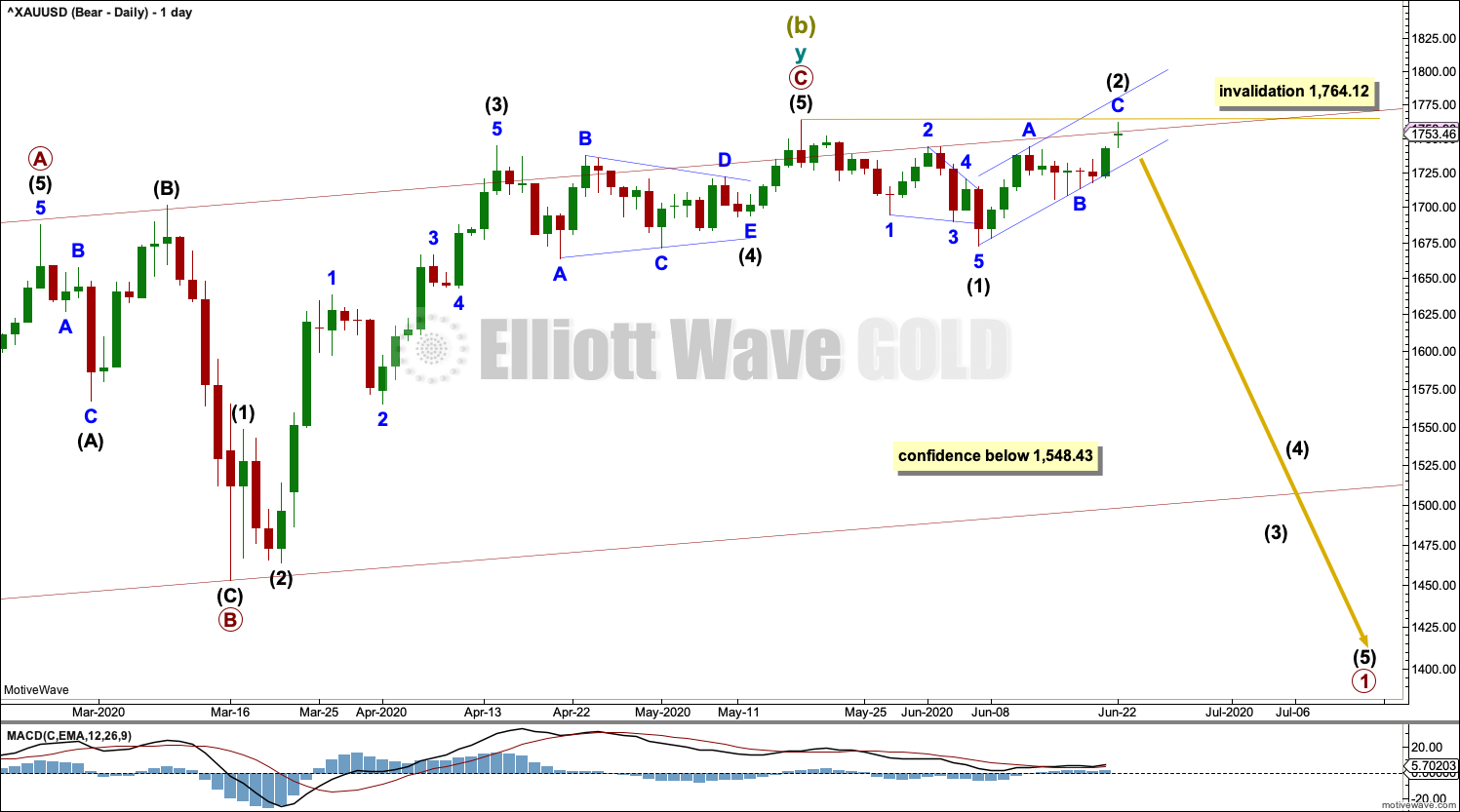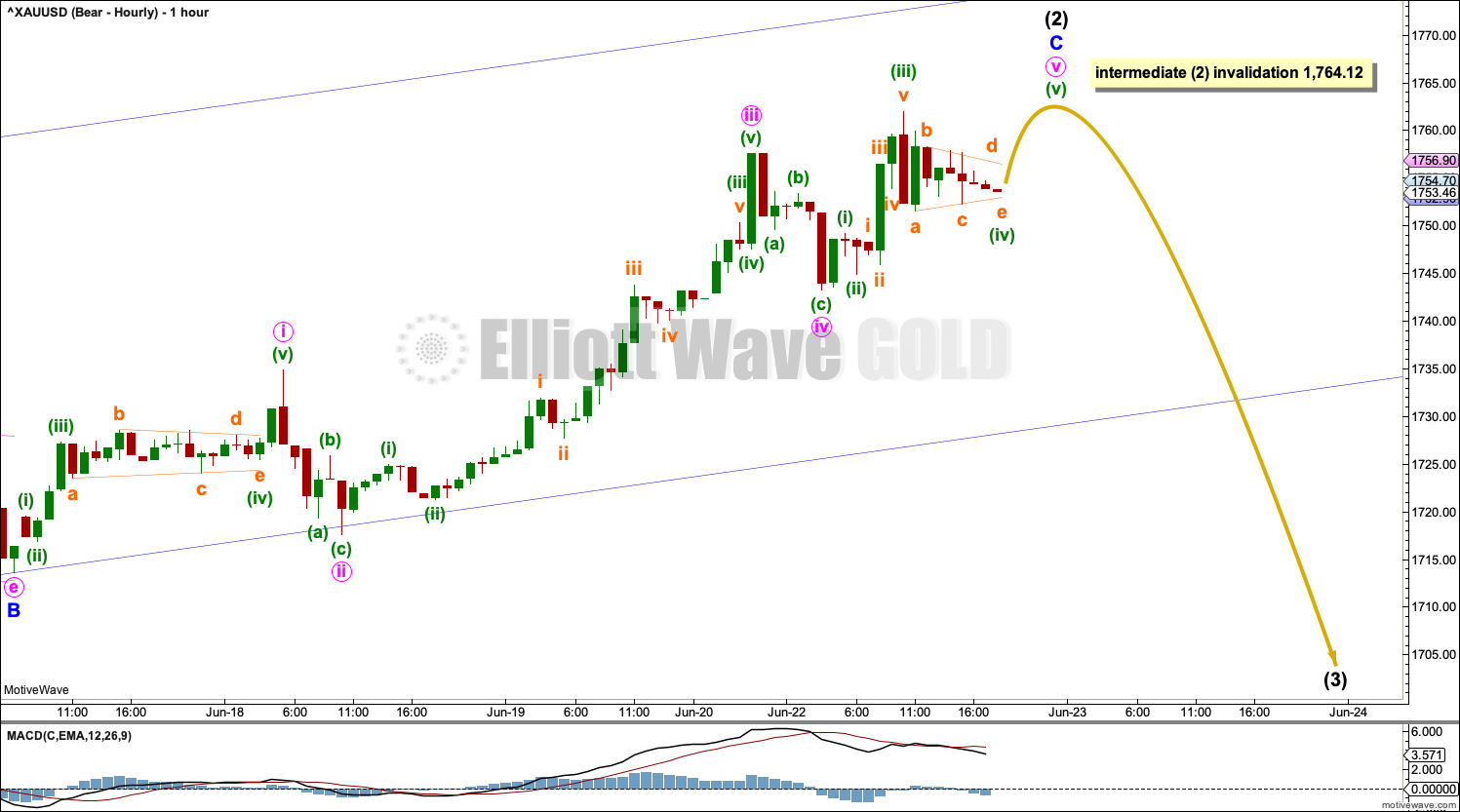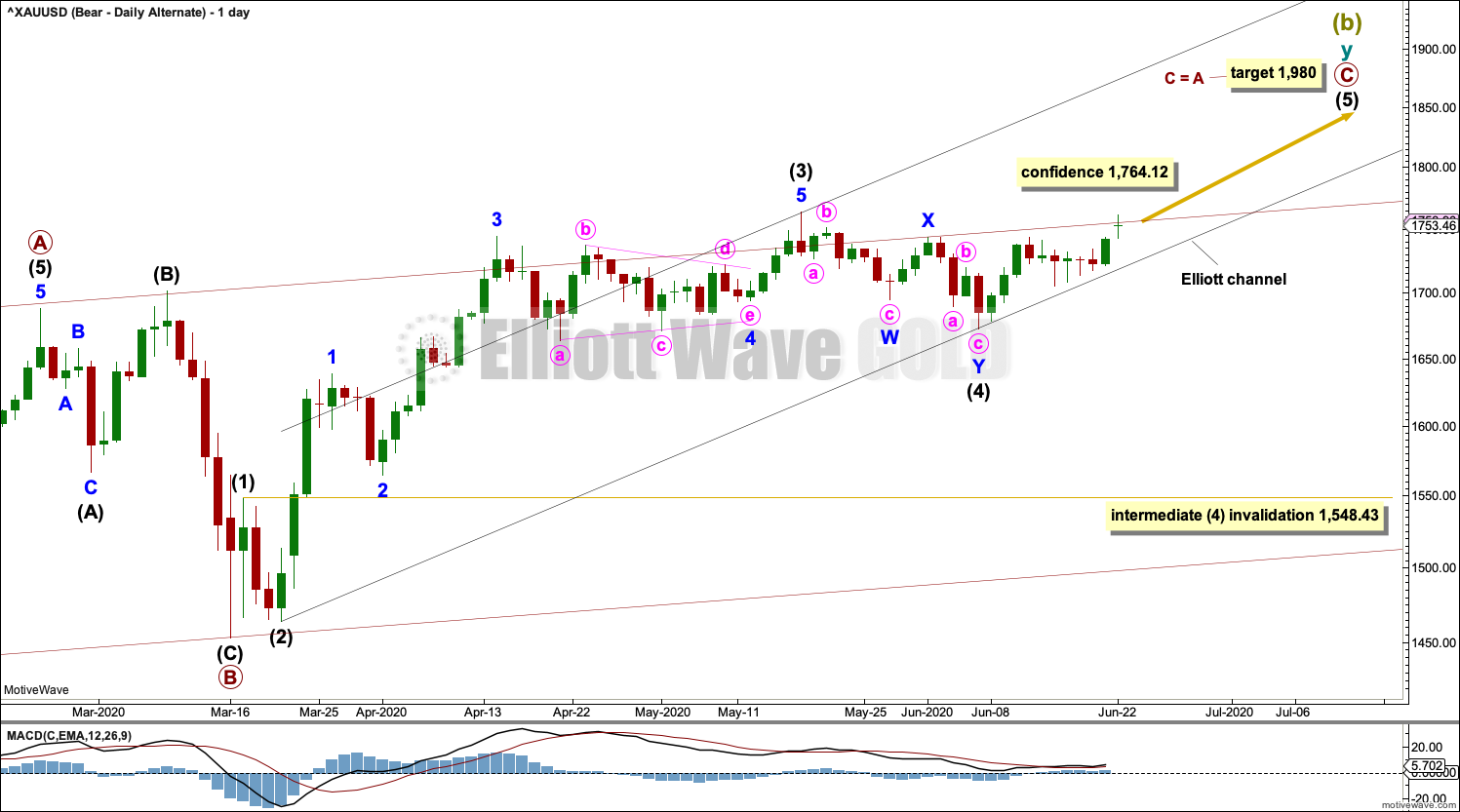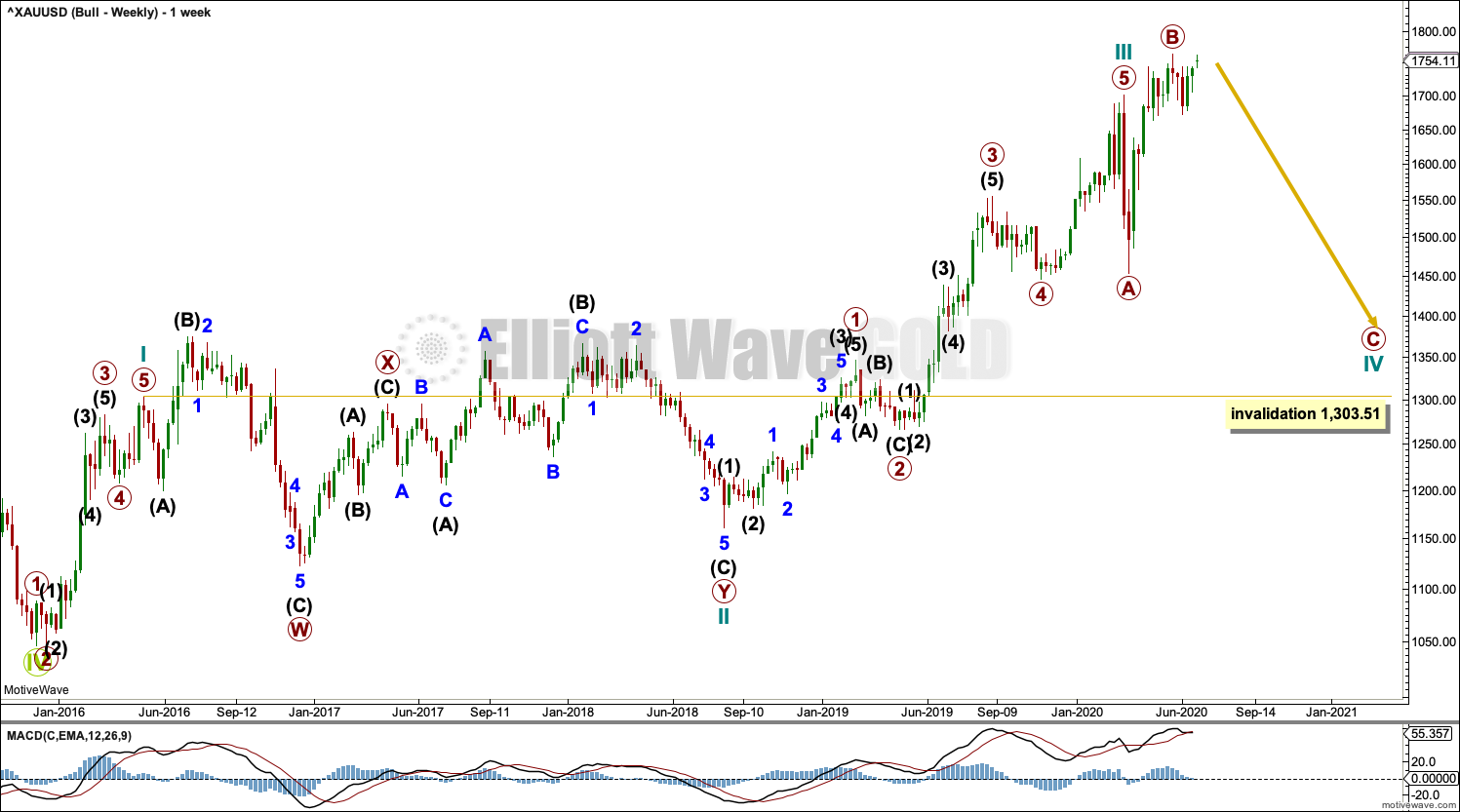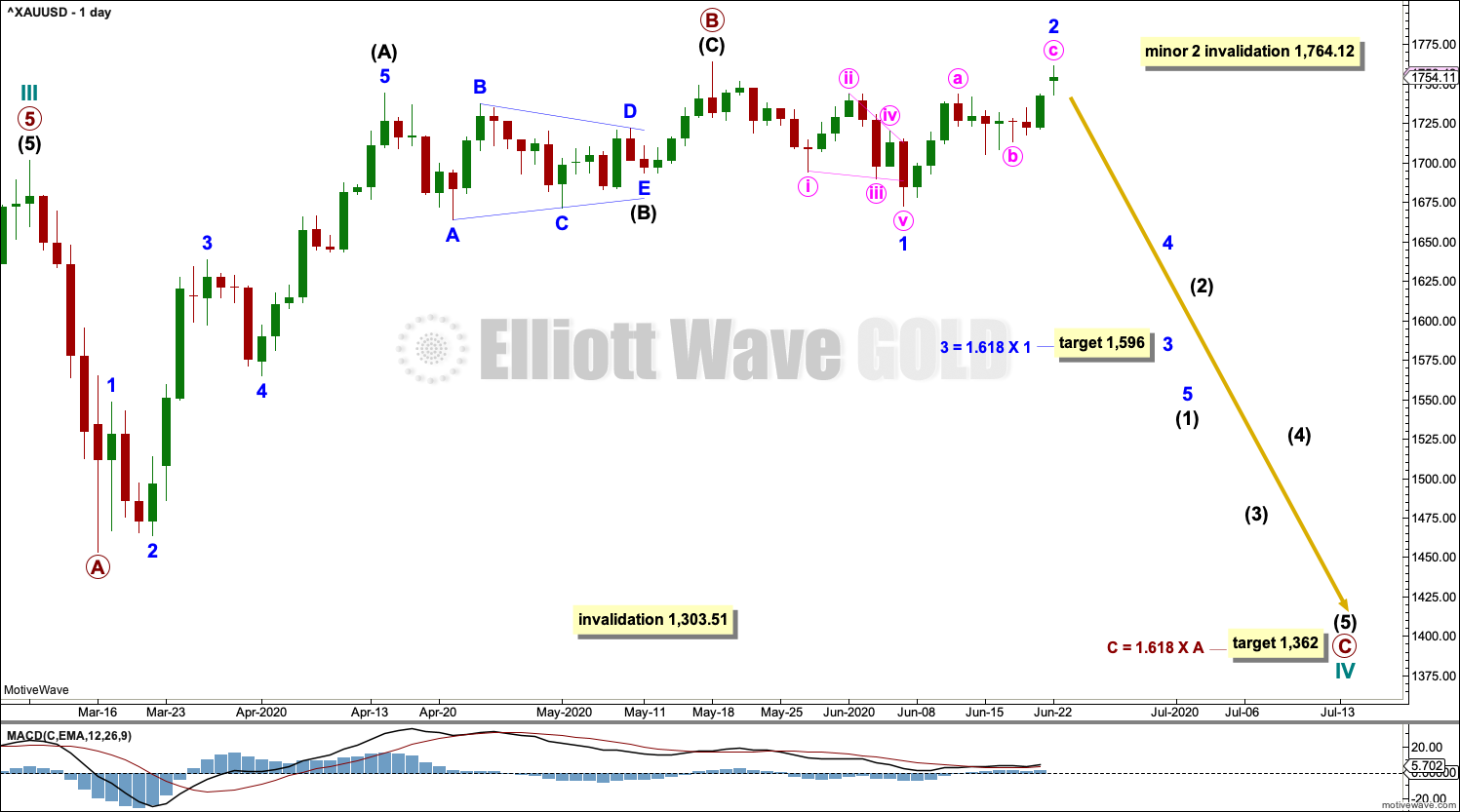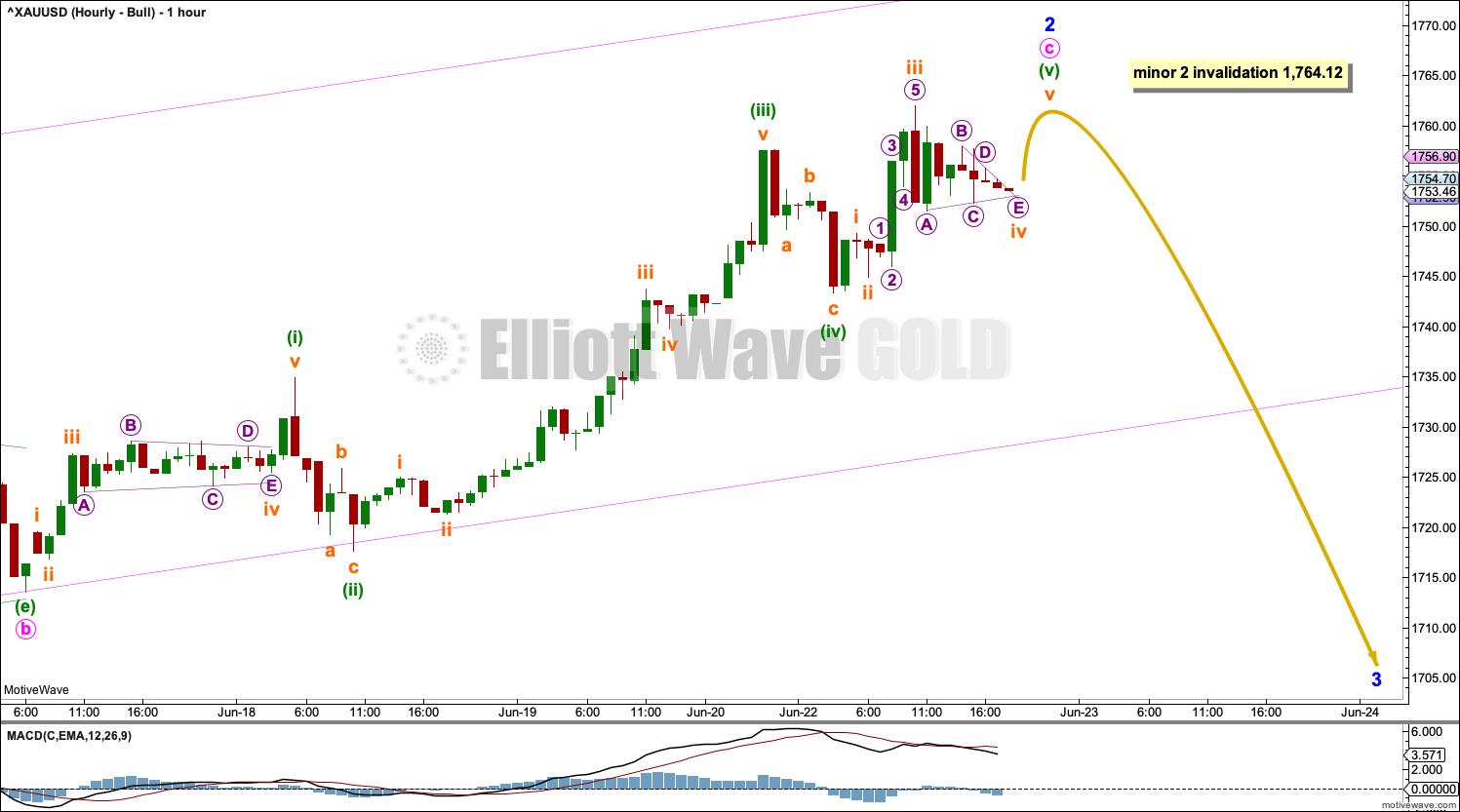GOLD: Elliott Wave and Technical Analysis | Charts – June 22, 2020
Price has reached resistance and Stochastics is entering overbought. An upwards swing within the consolidation may be completing here.
Summary: The longer price moves sideways in a consolidation the closer the breakout will be. With price moving sideways for over three weeks now, a breakout may be very close. Use the channel about intermediate wave (2) on the main daily chart as the earliest indication that a downwards breakout may be imminent; when this channel is breached, then a third wave down may begin.
A high may be in for Gold. Downwards movement may begin.
Confidence in a downwards trend may be had if price makes a new low below 1,548.43.
A new high above 1,764.12 would indicate an upwards breakout. The target would then again be at 1,980.
Grand SuperCycle analysis is here.
Monthly charts were last updated here.
MAIN BEARISH ELLIOTT WAVE COUNT
WEEKLY CHART
The bigger picture for this main bearish Elliott wave count sees Gold as still within a bear market, in a three steps back pattern that is labelled Grand Super Cycle wave IV on monthly charts.
Super Cycle wave (b) within Grand Super Cycle wave IV may be a complete double zigzag.
The first zigzag in the double is labelled cycle wave w. The double is joined by a three in the opposite direction, a combination labelled cycle wave x. The second zigzag in the double is labelled cycle wave y.
The purpose of the second zigzag in a double is to deepen the correction. Cycle wave y has achieved this purpose.
Super Cycle wave (c) downwards may continue to complete the larger (a)-(b)-(c) correction for Grand Super Cycle wave IV. Super Cycle wave (c) would be very likely to move below the end of Super Cycle wave (a) at 1,046.27 to avoid a truncation. When the bullish alternate wave count is invalidated, then a final target may be calculated for Super Cycle wave (c).
DAILY CHART
Primary wave C within cycle wave y may be a complete five wave impulse.
A new low below 1,693.39 has added initial confidence to this wave count. A new low below 1,548.43 would invalidate a new more bullish alternate wave count (see below), so it would add further confidence to this main wave count.
When primary wave 1 is complete within the new downwards trend, then primary wave 2 may not move beyond the start of primary wave 1 above 1,764.12.
Intermediate wave (2) may be an almost complete zigzag. Intermediate wave (2) may not move beyond the start of intermediate wave (1) above 1,764.12.
Draw a channel about the zigzag of intermediate wave (2). Draw the first trend line from the start of minor wave A to the end of minor wave B, then place a parallel copy on the end of minor wave A. When the lower edge of this channel is breached by downwards movement, then that may be taken as an indication that intermediate wave (2) may be over and intermediate wave (3) downwards may have begun.
HOURLY CHART
Intermediate wave (2) may be an incomplete zigzag. A target is calculated for minor wave C.
Only minuette wave (v) within minute wave v may be required to complete the structure.
In the short term, a new swing low below the start of minute wave v at 1,743.32 would indicate a trend change. Intermediate wave (2) at that stage would most likely be over.
Intermediate wave (2) may not move beyond the start of intermediate wave (1) above 1,764.12.
When intermediate wave (2) may be complete, then a target may be calculated for intermediate wave (3). That cannot be done yet.
ALTERNATE DAILY CHART
This alternate wave count has the lowest probability. Low probability does not mean no probability. An upwards breakout would see the main wave count invalidated, and then this alternate wave count would provide an expectation of the next movement for price.
It remains possible that primary wave C may be an incomplete five wave impulse.
Within the impulse: intermediate waves (1) through to (3) may be complete and intermediate wave (4) may have continued lower as a double zigzag. Intermediate wave (4) may not move into intermediate wave (1) price territory below 1,548.43.
An Elliott channel is drawn about primary wave C. Primary wave C does not fit well within this channel, which reduces the probability of this wave count.
ALTERNATE BULLISH ELLIOTT WAVE COUNT
WEEKLY CHART
This wave count sees the the bear market complete at the last major low for Gold on 3 December 2015.
If Gold is in a new bull market, then it should begin with a five wave structure upwards on the weekly chart.
Cycle wave I fits as a five wave impulse with reasonably proportionate corrections for primary waves 2 and 4.
Cycle wave II fits as a double flat. However, within the first flat correction labelled primary wave W, this wave count needs to ignore what looks like an obvious triangle from July to September 2016 (this can be seen labelled as a triangle on the bear wave count above). This movement must be labelled as a series of overlapping first and second waves. Ignoring this triangle reduces the probability of this wave count in Elliott wave terms.
Within the first flat correction labelled primary wave W of the double flat of cycle wave II, intermediate wave (B) is 1.69 the length of intermediate wave (A). This is longer than the common range of up to 1.38, but within an allowable guideline of up to 2. The length of intermediate wave (B) reduces the probability of this wave count.
Cycle wave III may be complete. Cycle wave IV may not move into cycle wave I price territory below 1,303.51.
DAILY CHART
Cycle wave IV may be an incomplete expanded flat correction. Primary wave A within the flat correction may have subdivided as a zigzag. Primary wave B may now be a complete zigzag. Primary wave B would be a 1.25 length of primary wave A. This is within the normal range for primary wave B within a flat from 1 to 1.38 times the length of primary wave A.
A target is calculated for primary wave C to end based upon the most common Fibonacci ratio to primary wave A within an expanded flat. Primary wave C must subdivide as a five wave motive structure.
It is still also possible that primary wave B could continue higher as a double zigzag. The common range of primary wave B would extend up to 1.38 times the length of primary wave A at 1,795.98. A maximum allowable guideline for primary wave B would be up to 2 times the length of primary wave A at 1,949.96. There is no Elliott wave rule stating a limit for B waves within expanded flat corrections, so there is no rule which may be used to determine an upper invalidation point for this wave count.
HOURLY CHART
Minor wave 1 may have completed as a leading contracting diagonal. Minor wave 2 may be an incomplete zigzag.
TECHNICAL ANALYSIS
WEEKLY CHART
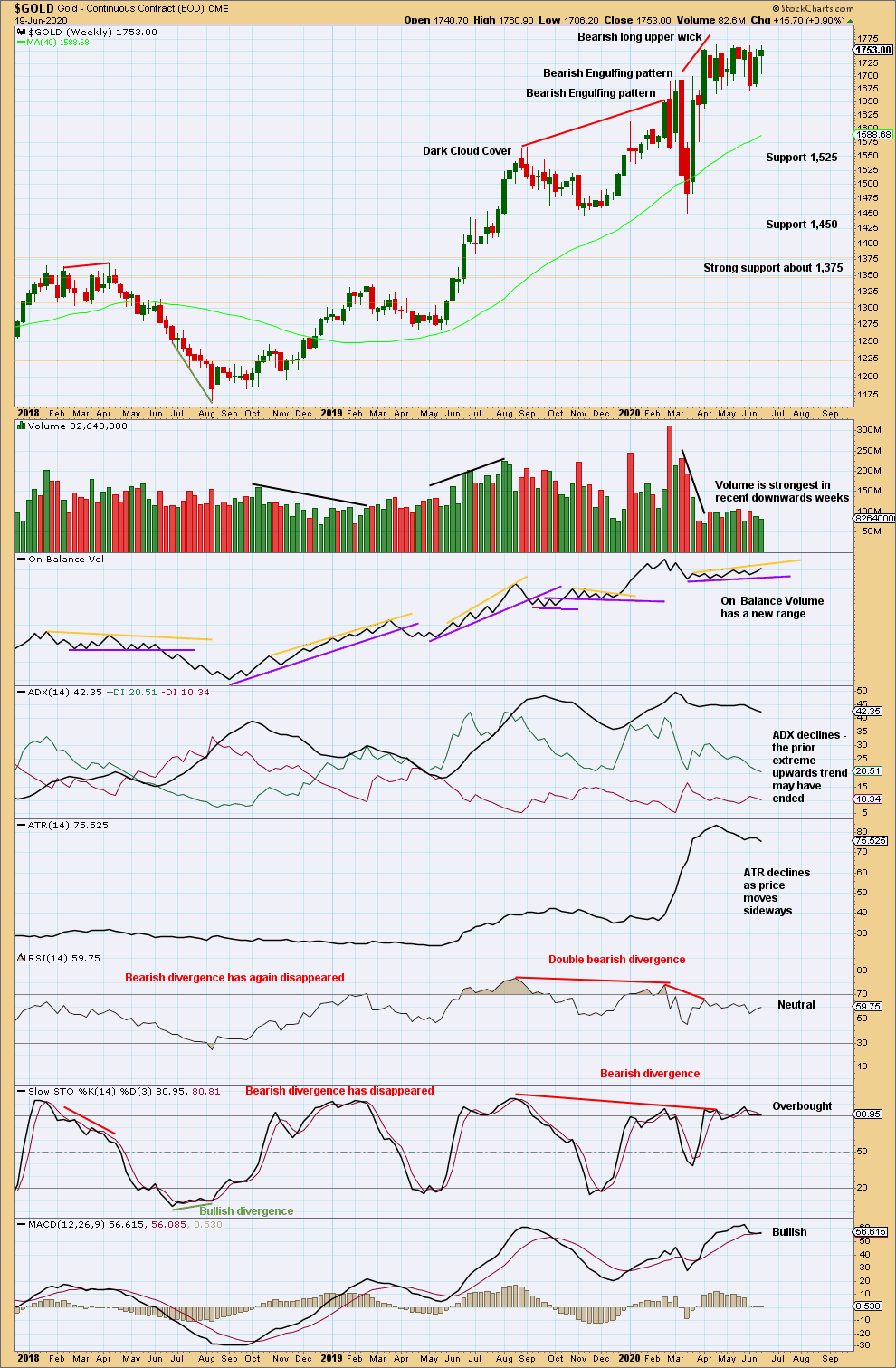
Click chart to enlarge. Chart courtesy of StockCharts.com.
Price remains within a consolidation with support about 1,665 to 1,680. The short-term volume profile is still bearish, suggesting a downwards breakout. Upwards movement within the last week lacks support from volume.
DAILY CHART
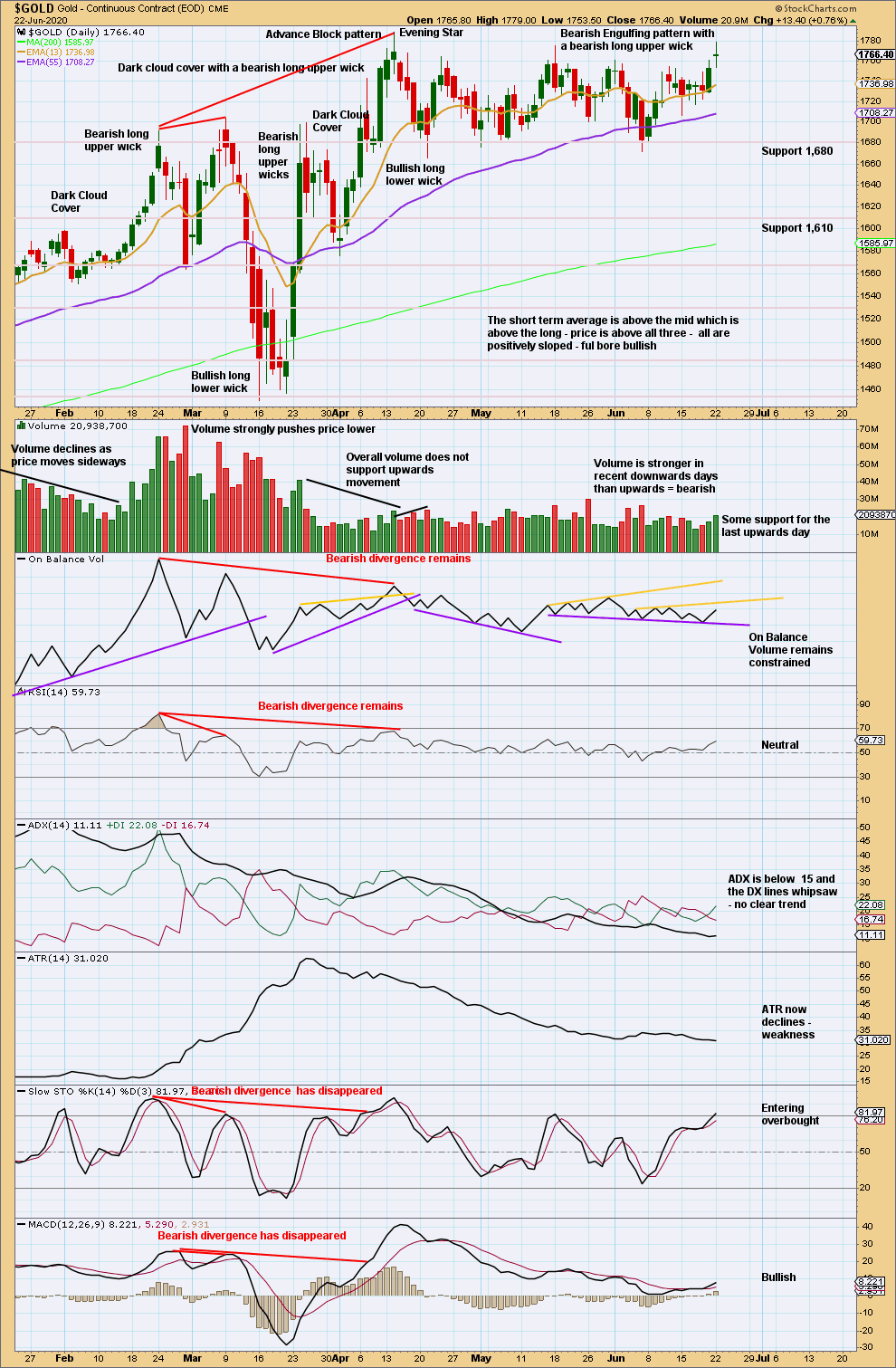
Click chart to enlarge. Chart courtesy of StockCharts.com.
Price remains range bound with support about 1,665 to 1,675 and resistance about 1,765 to 1,790. The short-term volume profile remains bearish, suggesting a downwards breakout may be more likely.
Both price and On Balance Volume are now tightly constrained. A breakout should now come very soon.
Today price has reached resistance and Stochastics is entering overbought. While price remains within the consolidation zone, it may be expected that an upwards swing may end about here and a downwards swing may begin. If price closes above resistance at 1,790, then that would constitute an upwards breakout; an upwards trend should then be expected.
For the very short term, support from volume today for upwards movement suggests a little more upwards movement tomorrow.
GDX WEEKLY CHART
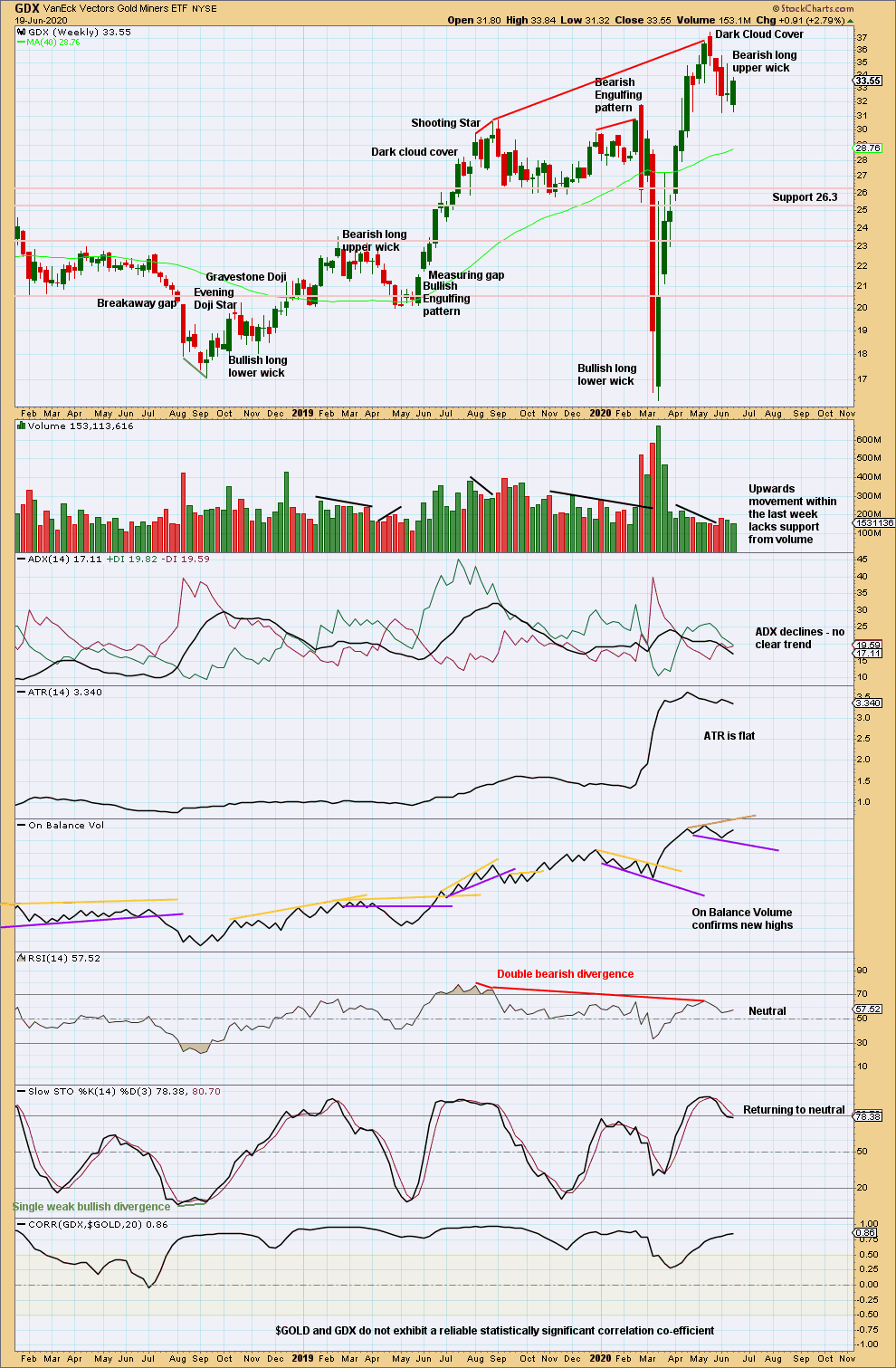
Click chart to enlarge. Chart courtesy of StockCharts.com.
The volume profile may be bearish, but this is best judged at the daily chart level this week.
GDX DAILY CHART
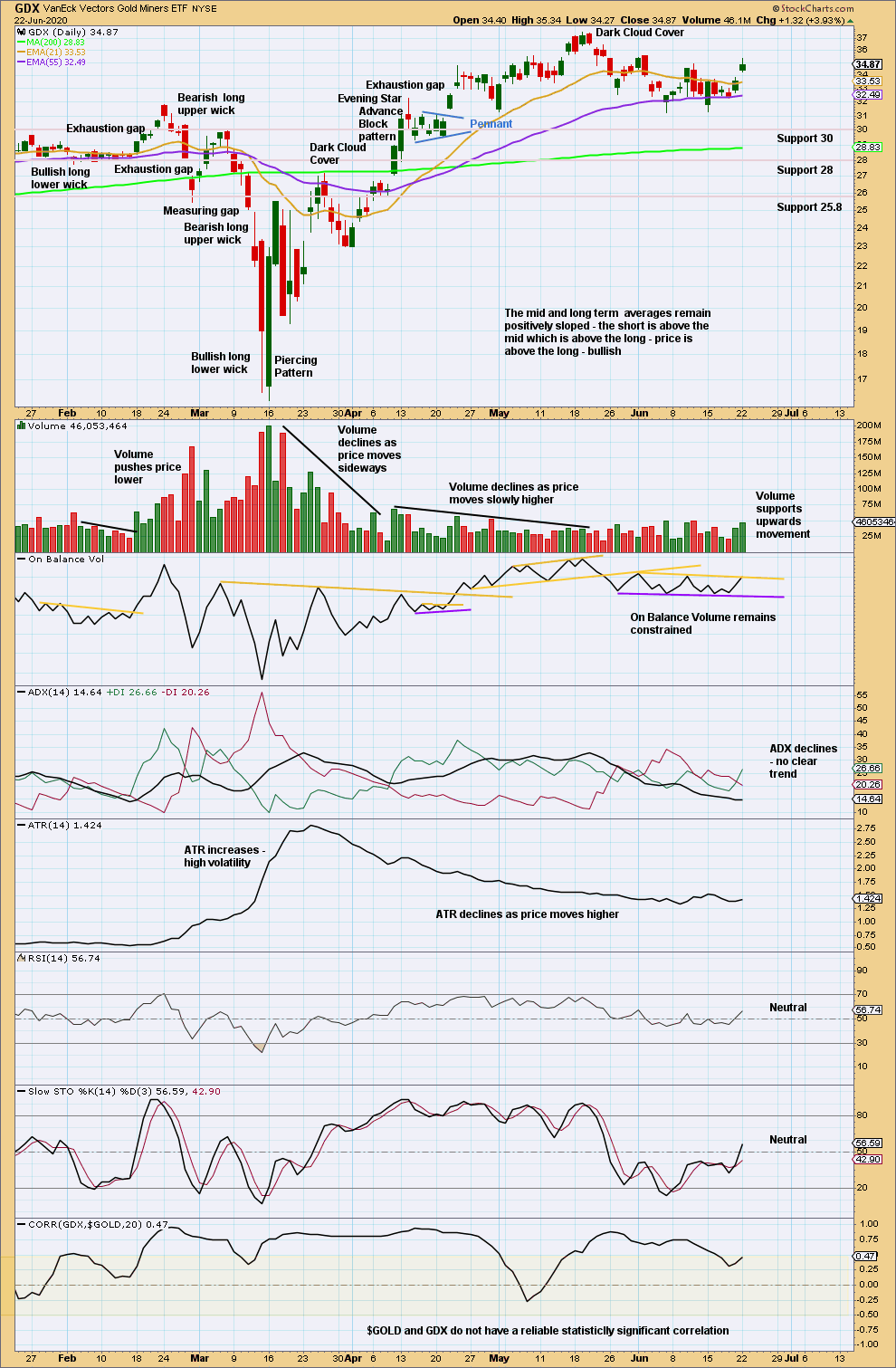
Click chart to enlarge. Chart courtesy of StockCharts.com.
A new short-term swing high above the last swing high of 11th of June makes the right hand shoulder of a possible Head and Shoulders pattern too messy for the right look. The pattern is not performing as expected, so it is discarded.
For the short term, volume suggests more upwards movement.
Price is range bound with resistance about 35.55 to 37.50 and support about 31.20 to 31.30. A breakout of this range is required before having confidence in a trend. An upwards breakout should have support from volume for confidence. A downwards breakout does not require volume for support.
Published @ 07:10 p.m. EST.
—
Careful risk management protects your trading account(s).
Follow my two Golden Rules:
1. Always trade with stops.
2. Risk only 1-5% of equity on any one trade.
—
New updates to this analysis are in bold.

